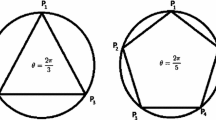Abstract
We examine the distribution of the ratio of addition to multiplication over standard atomic sets of integers. By analyzing the array of conversion ratios and selected sub-arrays, we prove that the reciprocal of the mean of the conversion ratio distribution converges to the prime-counting function π(n). We also show that the modified mean of the sub-array C 5, which is obtained from the array of conversion ratios by scaling and translation, converges to π(n) with an accuracy comparable to the Li-function. We go on to numerically show that the relative behaviors of L(n), \(1/H_{n}^{5}\) and Li(n) with respect to π(n) are similar, and that π(n)/L(n), \(\pi(n)/(1/H_{n}^{5})\) and π(n)/Li(n) provide approximations of competitive accuracy at the center of the distribution.







Similar content being viewed by others
References
du Sautoy, M.: The Music of the Primes: Searching to Solve the Greatest Mystery in Mathematics. Harper Collins, New York (2003)
Goldstein, L.J.: A history of the prime number theorem. Am. Math. Mon. 80(6), 599–615 (1973)
Legendre, A.M.: Essai sur la théorie des nombres, p. 394. Courcier, Paris (1808)
Gauss, C.F.: Werke, vol. II, pp. 444–447. Königliche Gesellschaft der Wissenschaften, Göttingen (1863)
Riemann, B.: Über die Anzahl der Primzahlen unter einer gegebenen Grösse. Monatsber. Preuss. Akad. Wiss., pp. 671–680 (1859)
de la Vallée Poussin, C.-J.: Sur la fonction ζ(s) de Riemann et le nombre des nombres premiers inférieurs une limite donnée. Mem. Cour. Acad. Roy. Belg. 59, 1 (1899)
Littlewood, J.E.: Sur la distribution des nombres premiers. C. R. Acad. Sci. Paris 158, 1869–1872 (1914)
Keating, J.P., Snaith, N.C.: Random matrix theory and \(\zeta(\frac{1}{2} + i t)\). Commun. Math. Phys. 214, 57–89 (2000)
Diaconis, P.: Patterns in eigenvalues: the 70th Josian Willard Gibbs lecture. Bull. Am. Math. Soc. 40(2), 155–178 (2003)
Kontoyiannis, I.: Counting primes using entropy. IEEE Inf. Theory Soc. Newsl., June 2008, pp. 6–9 (2008)
Bach, E., Klyve, D., Sorrenson, J.P.: Computing prime harmonic sums. Adv. Comput. Math. 5(4), 417–442 (2009)
Author information
Authors and Affiliations
Corresponding author
Rights and permissions
About this article
Cite this article
Jeong, S., Lee, G. & Kim, G. Statistical and structural analysis of the appearance of prime numbers. J. Appl. Math. Comput. 41, 283–299 (2013). https://doi.org/10.1007/s12190-012-0601-9
Received:
Published:
Issue Date:
DOI: https://doi.org/10.1007/s12190-012-0601-9
Keywords
- Prime number
- Prime counting function
- Prime number theorem
- Conversion ratio
- Conversion ratio array
- Conversion ratio distribution




